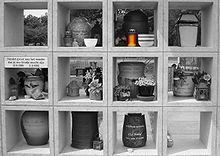- Urn
-
For other uses, see Urn (disambiguation).
 Maya funerary urn
Maya funerary urn
 Lustration urn from Pergamon. This is one of two huge urns now in the Hagia Sophia in Istanbul. They date from Hellenistic times.
Lustration urn from Pergamon. This is one of two huge urns now in the Hagia Sophia in Istanbul. They date from Hellenistic times.
An urn is a vase, ordinarily covered, that usually has a narrowed neck above a footed pedestal. "Knife urns" placed on pedestals flanking a dining-room sideboard were an English innovation for high-style dining rooms of the late 1760s. They went out of fashion in the following decade, in favour of knife boxes that were placed on the sideboard.
In Classical terms, an urn is a large decorative covered container of wood, metal, pottery, etc. In furniture, it was a large wooden vase-like container which was usually set on a pedestal on either side of a side table. This was the characteristic of Adam designs and also of Hepplewhite's work. Urns were also used as decorative turnings at the cross points of stretchers in 16th and 17th century furniture designs. The urn and the vase were often set on the central pedestal in a "broken" or "swan's" neck pediment.[1]
Contents
Cremation urns
Funerary urns (also called cinerary urns and burial urns) were used by many civilizations. After a person died, survivors cremated the body and collected the ashes in an urn (see also lekythos, a type of pottery in ancient Greece used for holding oil in funerary ritual). In the Bavarian tradition, a king's heart would be placed in the urn upon his death (as happened with King Otto of Bavaria in 1916). Cremation urns were also commonly used in Anglo Saxon England.[2]
Romans placed the urns in a niche in a collective tomb called a columbarium (literally, dovecote). The interior of a dovecote usually has niches to house doves.
The discovery of a Bronze Age urn burial in Norfolk, England prompted Sir Thomas Browne to carefully describe the antiquities found. He expanded his study to survey burial and funerary customs, ancient and current, and published it as Hydriotaphia or Urn Burial (1658).
Other urns
 The Ashes urn.
The Ashes urn.
The Ashes, the prize in the biennial Test cricket competition between England and Australia, are contained in a miniature urn.
Urns are a common form of architectural detail and garden ornament. Well-known ornamental urns include the Waterloo Vase.
In mathematics, an urn problem is a thought experiment in probability theory.
A tea urn is a heated metal container traditionally used to brew tea or boil water in large quantities in factories, canteens or churches. They are not usually found in domestic use. Like a samovar it has a small tap near the base for extracting either tea or hot water. Unlike an electric water boiler, tea may be brewed in the vessel itself, although they are equally likely to be used to fill a large teapot.
See also
- Bridge spouted vessel
- Crematory
- Pithos
- Viewlogy
Notes
- ^ Martin Pegler, The Dictionary of Interior Design.
- ^ See, for example, the Wold Newton urns — www.woldnewton.net.
External links
- Daily Mail article on a Roman cinerary urn
- Cremation urn examples
- More Cremation Urns Examples
- Wood Cremation Urns Examples
- Getty. Art & Architecture Thesaurus. Urns
Categories:- Containers
- Garden vases
- Death customs
Wikimedia Foundation. 2010.

